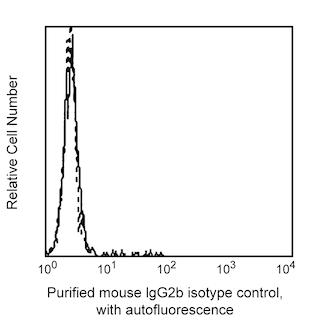-
Your selected country is
Middle East / Africa
- Change country/language
Old Browser
This page has been recently translated and is available in French now.
Looks like you're visiting us from {countryName}.
Would you like to stay on the current country site or be switched to your country?


Regulatory Status Legend
Any use of products other than the permitted use without the express written authorization of Becton, Dickinson and Company is strictly prohibited.
Preparation And Storage
Recommended Assay Procedures
Functional Studies: ICAM-1 is a ligand for both the leukocyte function-associated antigen-1 (LFA-1) and Mac-1, and thereby mediates the adhesion of leukocytes to endothelial cells. Leukocyte binding to endothelial cells is a critical process in inflammatory responses such as rheumatoid arthritis, adult respiratory distress syndrome, chronic dematoses, and reperfusion myocardial injury. Anti-ICAM-1 monoclonal antibody (clone LB-2) inhibits phorbol ester-enhanced aggregation of EBV-B or lectin-activated normal blood mononuclear cells. Anti-ICAM-1 (clone LB-2) is specific for a functional epitope on ICAM-1 and inhibits LFA-1-ICAM-1 interactions.
Immunoprecipitation: Under reducing conditions, anti-ICAM-1 monoclonal antibody (clone LB-2) immunoprecipitates a glycoprotein from EBV-immortalized B lymphocytes (EBV-B) with a molecular mass of 84 kDa by gel electrophoresis, while under nonreducing conditions a molecular mass of 77 kDa was observed.
Immunohistology: Anti-ICAM-1 monoclonal antibody (clone LB-2) can be used for immunohistochemistry staining.
Product Notices
- Since applications vary, each investigator should titrate the reagent to obtain optimal results.
- Please refer to www.bdbiosciences.com/us/s/resources for technical protocols.
- Caution: Sodium azide yields highly toxic hydrazoic acid under acidic conditions. Dilute azide compounds in running water before discarding to avoid accumulation of potentially explosive deposits in plumbing.
Companion Products

.png?imwidth=320)
The LB-2 monoclonal antibody specifically binds to CD54 which is also known as Intercellular adhesion molecule-1 (ICAM-1). CD54 is an 85-110 kDa type I transmembrane glycoprotein that belongs to the immunoglobulin supergene family. A soluble form of CD54 can also be found in biological fluids. CD54 is expressed on endothelial cells and both resting (weak) and activated (moderate) T and B lymphocytes and monocytes. CD54 is expressed on human myeloma cells, Burkitt's lymphoma cells, erythroleukemia cells, and B-lymphoblastoid cells. CD54 is a ligand for LFA-1 (CD11a/CD18) and Mac-1 (CD11b/CD18) and can act as a receptor for Rhinoviruses. The CD54 adhesion molecule plays roles in inflammatory and immune responses and neoplasia.
Development References (10)
-
Bevilacqua MP, Pober JS, Mendrick DL, Cotran RS, Gimbrone MA Jr. Identification of an inducible endothelial-leukocyte adhesion molecule. Proc Natl Acad Sci U S A. 1987; 84(24):9238-9242. (Biology). View Reference
-
Bevilacqua MP, Stengelin S, Gimbrone MA Jr, Seed B. Endothelial leukocyte adhesion molecule 1: an inducible receptor for neutrophils related to complement regulatory proteins and lectins. Science. 1989; 243(4895):1160-1165. (Biology). View Reference
-
Bochner BS, Luscinskas FW, Gimbrone MA Jr, et al. Adhesion of human basophils, eosinophils, and neutrophils to interleukin 1-activated human vascular endothelial cells: contributions of endothelial cell adhesion molecules. J Exp Med. 1991; 173(6):1553-1557. (Biology). View Reference
-
Clark EA, Ledbetter JA, Holly RC, Dinndorf PA, Shu G. Polypeptides on human B lymphocytes associated with cell activation. Hum Immunol. 1986; 16(1):100-113. (Biology). View Reference
-
Diamond MS, Staunton DE, de Fougerolles AR, et al. ICAM-1 (CD54): a counter-receptor for Mac-1 (CD11b/CD18). J Cell Biol. 1990; 111(6):3129-3139. (Biology). View Reference
-
Lo SK, Lee S, Ramos RA, et al. Endothelial-leukocyte adhesion molecule 1 stimulates the adhesive activity of leukocyte integrin CR3 (CD11b/CD18, Mac-1, alpha m beta 2) on human neutrophils. J Exp Med. 1991; 173(6):1493-1500. (Biology). View Reference
-
Luscinskas FW, Cybulsky MI, Kiely JM, Peckins CS, Davis VM, Gimbrone MA Jr. Cytokine-activated human endothelial monolayers support enhanced neutrophil transmigration via a mechanism involving both endothelial-leukocyte adhesion molecule-1 and intercellular adhesion molecule-1. J Immunol. 1991; 146(5):1617-1625. (Biology). View Reference
-
Makgoba MW, Sanders ME, Ginther Luce GE, et al. ICAM-1 a ligand for LFA-1-dependent adhesion of B, T and myeloid cells. Nature. 1988 January; 331(6151):86-88. (Biology). View Reference
-
Patarroyo M, Clark EA, Prieto J, Kantor C, Gahmberg CG. Identification of a novel adhesion molecule in human leukocytes by monoclonal antibody LB-2. FEBS Lett. 1987 January; 210(2):127-131. (Biology). View Reference
-
Phillips ML, Nudelman E, Gaeta FC, et al. ELAM-1 mediates cell adhesion by recognition of a carbohydrate ligand, sialyl-Lex. Science. 1990; 250(4984):1130-1132. (Biology). View Reference
Please refer to Support Documents for Quality Certificates
Global - Refer to manufacturer's instructions for use and related User Manuals and Technical data sheets before using this products as described
Comparisons, where applicable, are made against older BD Technology, manual methods or are general performance claims. Comparisons are not made against non-BD technologies, unless otherwise noted.
For Research Use Only. Not for use in diagnostic or therapeutic procedures.
Report a Site Issue
This form is intended to help us improve our website experience. For other support, please visit our Contact Us page.